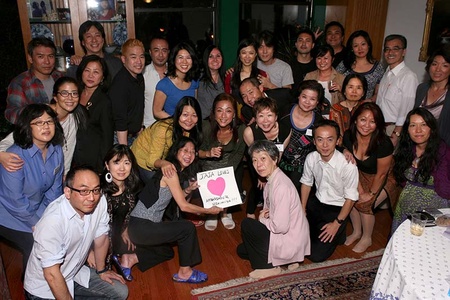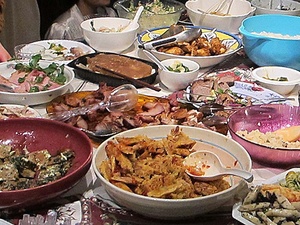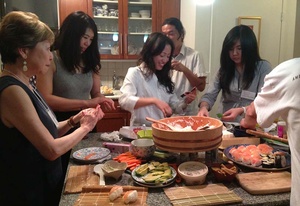I lived in Manhattan for 13 years before I went to my first JAJA meeting. An acronym for Japanese Americans and Japanese in America, JAJA is an informal group that meets monthly in a large and accommodating loft space near Union Square. On my first visit, I exited the elevator on the third floor of a former commercial building and heard a muffled din coming from behind a door to my right. I opened it and entered a boisterous world brimming with loud talk, a clatter of kitchen sounds, and the smell of good food. By virtue of existing for years without my knowledge, the place felt underground, magical, a culturally specific speakeasy to which I had just been given the password.
I was greeted at the door by a kindly Nisei woman named Alyce Matsumoto (no relation). A long line of shoes lined up against a hallway wall immediately tipped me off to the fact that this was a Japanese-style, bare or slippered-feet kind of apartment. There was an astounding number of Nikkei in the room, something I had never seen before in New York. Even though I grew up in the Los Angeles area on a street that was entirely Japanese American, this was different. It was multi-generational and bi-lingual, and more freewheeling and raucous than my old neighborhood, Japan Society events, international gatherings I’ve attended in Japan, or even a UCLA Asian American sorority dance to which I was once invited.
JAJA’s monthly meetings always feature a speaker, or sometimes a performer. I don’t recall who it was that night. What I do remember is food. A large dining room table was tightly packed with homemade Japanese specialties and a sideboard was loaded with desserts. There was chirashizushi, futomaki, inarizushi, stir fried vegetables, shumai, kinpira gobo, many other vegetable and salad preparations, and teriyaki beef. A large slab of salmon came out on a wooden plank, delicious under its broiled topping, a mixture of mayonnaise and miso. This, I decided, was my kind of meeting.
After the speaker came the announcements. There was a bazaar at the Buddhist church, Day of Remembrance announcements, and a number of artists rose to invite JAJA members to their openings, recitals, plays, or performances happening around the boroughs of New York. I had no idea that there were so many Japanese and Japanese Americans doing so many things here! It was an introduction to a creative community that has become, as founding member Stann Nakazono put it, “a home away from home for a lot of people, a place to get a home-cooked meal and be themselves.”
“What I like about JAJA,” says photographer and JAJA member George Hirose, a self-described “East Coast Nisei,” “is the kind of informality of it. What brings us together are topics important to both Japanese Americans and Japanese in America, but it’s a very casual, friendly organization without a lot of rules and restrictions. That attracts people who aren’t into structured organization. It’s like hanging out with friends and making new friends.”
While total membership is about 500, at any given meeting you might encounter anywhere from 40 to 60 people in attendance. This warm and welcoming community began 10 years ago, when Nakazono, also a filmmaker, moved to New York and missed the large Gardena JA community he had been a part of. The son of a Kibei Nisei and a Japanese mother, Nakazono moved to New York in 2003 to join friends in the large circle of independent filmmakers here. Early on, he wondered, “Where are all the Japanese Americans?” He went to a JACL meeting, but found it lacking in the sense of community he was looking for.

JAJA group photo at a meeting to commemorate the memory of the late Ambassador Shinichi Nishimaya, September 25, 2012. Photo credit: George Hirose
One day, helping out on a project with photographer Corky Lee at Lincoln Center, Nakazono met another Japanese American filmmaker, Yonsei Colorado native Jennifer Takaki. “You’re the first Japanese American guy I’ve met who’s not related to me!” she exclaimed. Nakazono’s response, “We’ve got to do something about this.”
The first JAJA meeting took place in the fall of 2004 in an East Village diner in the pouring rain. Only two people were there, Nakazono and filmmaker, playwright, and life purpose coach Donna Tsufura, who coined the name JAJA to reflect that it was not strictly a Japanese American organization. When Nakazono was first forming JAJA, he recalls, a number of Japanese New Yorkers told him, “I don’t consider myself JA, but bilingual and bicultural.” He adds, “there’s a whole generation [here] that doesn’t consider itself in that [JA] category.”
JAJA’s growth has been organic, says Nakazono. In those early days, meetings were often held in Takaki’s spacious apartment and consisted of a group of five to ten people sharing chips, salsa, and a bottle of wine. Most were filmmakers or artists who showed their films or talked about their work. Soon, the idea of featuring a speaker or performer at each meeting took hold. Performers have ranged from a JA hula group, opera singers, classical pianists, ballroom dancers, and ballet performances, while authors, community activists, and filmmakers have discussed their work. After the last Tule Lake Pilgrimage, a group of JAJA members discussed their experience at the event. Other topics have ranged from the Japanese Canadian experience, LGBT issues, and a comparison of cyber bullying in Japan and America.
For Takaki, being a part of JAJA has been a revelatory experience. Growing up in Pueblo, Colorado with American-born paternal grandparents, she says, “We didn’t even know we were Asian, we were just trying to fit in.” Her mother, whose father was Issei and mother was Nisei, did try to pass on Japanese traditions. On a family visit to the local reservoir, a popular picnicking spot, Takaki recalls, “while everyone else was eating sandwiches, my mother had rice balls and teriyaki hot dogs for us to eat with chopsticks. It was embarrassing at the time, but has become a fond benchmark memory of my mother trying to instill culture in an otherwise non-Japanese environment.”
About a year after the first JAJA meeting, Nakazono met Julie Azuma, a Sansei who had arrived from Chicago in 1971 to work in the fashion industry. The redress movement politicized Azuma, and brought her back to the Japanese American community, which had been a large part of her family’s life in Chicago. She worked alongside Yuri and Bill Kochiyama and Michi and Walter Weglyn at gatherings held at the Japanese American United Church on Seventh Avenue. “There is an enormous community of especially Nisei who have passed on, and we had this wonderful energy, and drive,” recalls Azuma. The JACL was opposed to bringing redress commission hearings to New York, but three separate groups formed around the cause, succeeded in bringing Redress Commission hearings to New York and helped win victory for the movement.
By the time Nakazono met Azuma, she had started her own business selling educational materials and tools for families with autistic children, and was active in a wide network of Japanese and Asian American organizations. In her experience, “people from California usually went back,” Azuma recalls, “so I stopped being nice to them, investing in them and caring for them. Hawaiians were okay, but not Californians. I figured Stann would go back.”
Azuma and her then-husband, bi-racial Sansei Tamio Spiegel, offered their loft apartment for a JAJA meeting, made them some food, and planned to go out. But JAJA members convinced them to stay for the meeting. The goings on were so interesting and the meeting so fun that the couple was hooked. It was at this point that the food at JAJA meetings started to get more elaborate. “Tamio and I used to have a cook-off between ourselves,” recalls Azuma. “He did quality and I did quantity.” Spiegel recalls in the early days even trying to cook food around the evening’s theme. For the dinner on the history of Japanese Canadians, he says, “I made a poutine that consisted of fried satoimo (taro root) sticks, instead of French fries, and covered them in a shoyu-miso gravy over a creamy tofu that replaced cheese curds.” After several years of doing most of the cooking, the meetings evolved into more of a potluck, and those who did not cook or bring food were asked to donate $10 each to help defray costs. More recently, a food committee was formed to try to ensure that there is enough balance and variety on the table.
Over the years, says Azuma, the food on the potluck table has reflected the change in membership. “Even what the food committee considers down home food is so different from the Japanese American food we were presenting early on,” says Azuma. “It’s much more Japanesey. Last time it was okonomiyaki and vegetable curry. It’s much more like Japan than my scrambled egg and bacon fried rice.” The recent arrival of member Eric Takahashi—the the son of shin-Issei who arrived in the United States in the late ’60s and a cook at Gramercy Tavern restaurant—has helped focus the increasingly authentic trend of the potlucks. In the fall for example, Takahashi gave a well-received class on how to make one-pot nabe-style dishes. The groaning JAJA dinner table, says Azuma, “has become a new vision of our community.”

Chef Eric Takahashi of Gramercy Tavern and JAJA members at his hot-pot cooking demonstration, November 2013. The event honored Consulate-General of Japan in New York Consul Fumiho Suzawa (center, in black, next to Chef Eric in white chef uniform), who was attending her last JAJA meeting before returning to Japan for a new post Photo credit: S. Nakazono
Finding a semi-permanent home in Azuma’s 18th Street loft—along with hosting assistance offered by JAJA member Marianne Yoshioka and her husband Ernst Vanbergeijk at their Upper West Side apartment—was a turning point that allowed the organization to flourish. A second key event, many members agree, was being embraced by Consul General of Japan Motoatsu Sakurai in New York. Azuma credits lawyer and JA community activist Susan Onuma for bringing JAJA to the attention of the consul general, and suggesting that consulate members meet with JAJA. “It helped give us great validity,” says Azuma. The longstanding relationship has resulted in invitations to JAJA members to receptions at the consulate. Spiegel agrees that the relationship “gave the Japanese Americans in JAJA a sense of belonging.” As the son of a European American father and Nisei mother who grew up in New York, he recalls, “Before JAJA, it was a lot of work to be a Japanese American in New York; you had to seek out community.”

The late Japanese Consul-General in New York City and Japanese Ambassador to China Shinichi Nishimiya and his wife Yukiko at a JAJA Christmas party, December 2010. Photo credit: George Hirose
In recent years, JAJA has proved to be an effective conduit for organizing fundraising and relief efforts for different causes. When the massive earthquake and tsunami struck the Tohoku region in March 2011, JAJA postponed its scheduled speaker that month and instead featured speakers who could update the group on what was going on there and how members could help. A filmmaker and former JAJA member happened to be in Tohoku when the disaster hit, and began filming as events unfolded. Fellow filmmaker and JAJA member Naomi Mizoguchi arranged to show that footage at a JAJA meeting and fundraiser for disaster relief. Other JAJA members traveled to Japan to volunteer for cleanup and other duties in the Tohoku region.
Similarly, in the aftermath of superstorm Sandy in 2012, when large swaths of the city lost power, the JAJA Facebook page served as a clearing house for information on where members could go for hot showers or a place to stay.
Yet JAJA has had its growing pains, too. As membership has grown larger and increasingly diverse, discussion has centered on the issue of whether non-Nikkei significant others, spouses, and guests should be allowed to attend meetings. Some members, says Azuma, especially those who were involved in the civil rights movement and the fight for redress and reparations feel it’s important to be open and inclusive. Others feel safer and more likely to honestly voice their opinions and feelings with a group that shares their Japanese heritage. In a recent discussion a core group of JAJA members agreed to open future meetings to non-Nikkei spouses and significant others, leaving open the possibility that certain meetings be closed at the request of the organizer.
Word of JAJA has spread, and there has been interest in replicating it in other cities. A Denver Nikkei group has contacted Nakazono for details on how the group is organized. Nakazono explained to them, “We talk about JA history and we talk about camp. A lot of people here don’t know about it, though it’s not that they don’t care about it. But it’s not the only thing that represents the JA community. We talk about being biracial, or LGBT, or Japanese high school baseball.” Nakazono himself is well aware of the history of Japanese Americans during World War II. His grandmother took his father and his siblings to Japan before the war, but his grandfather was imprisoned in Minidoka and transferred to Tule Lake, where he later passed away.
For founding member Donna Tsufura, a playwright and filmmaker whose parents met in New York City after confinement in World War II concentration camps (her father was among many West Coast internees who relocated to the East Coast to work in Seabrook, NJ), one of the best features of JAJA is how it brings JAs and Japanese nationals into contact. “You’ll find a lot of Japanese here say ‘I never talk to Japanese Americans, and this is the place where I first began to, and vice versa,” she says. Being a longtime member has been “phenomenal,” she adds. “I have a life commitment to it, and in this world of global citizens, to empowering each other. I really value my Japanese heritage.”
© 2014 Nancy Matsumoto









